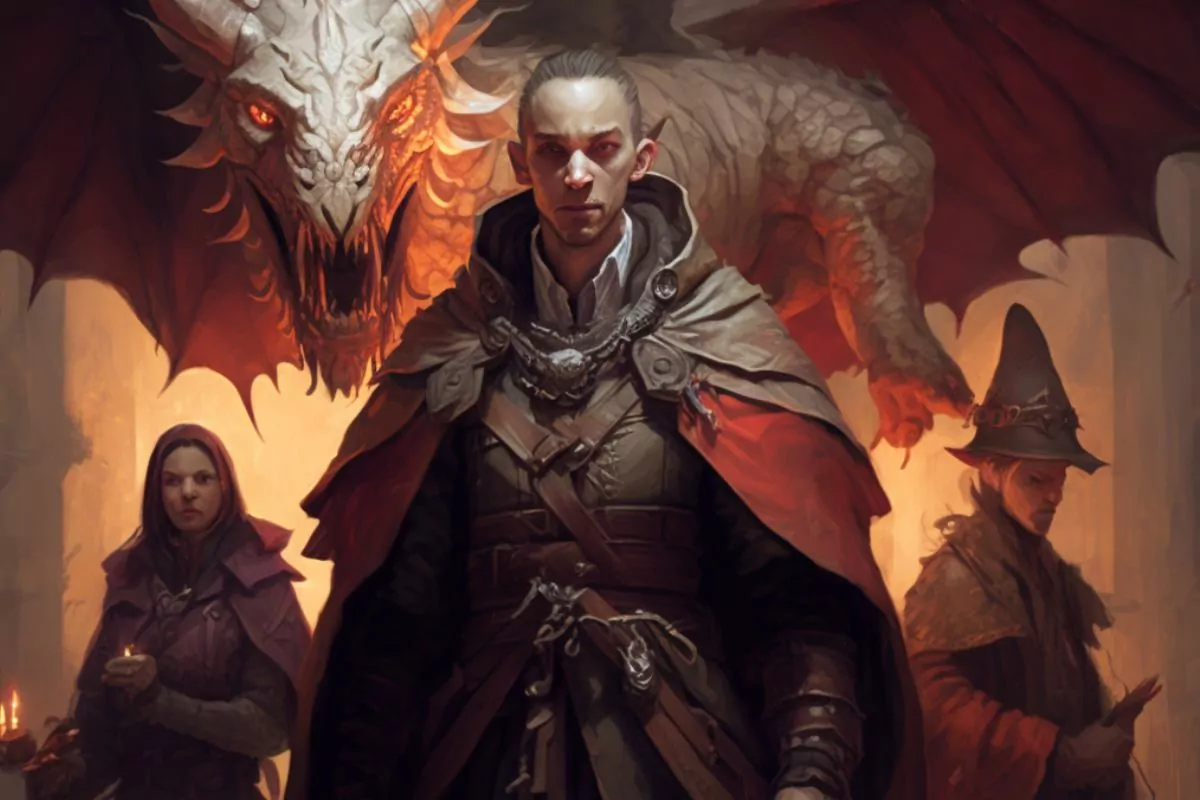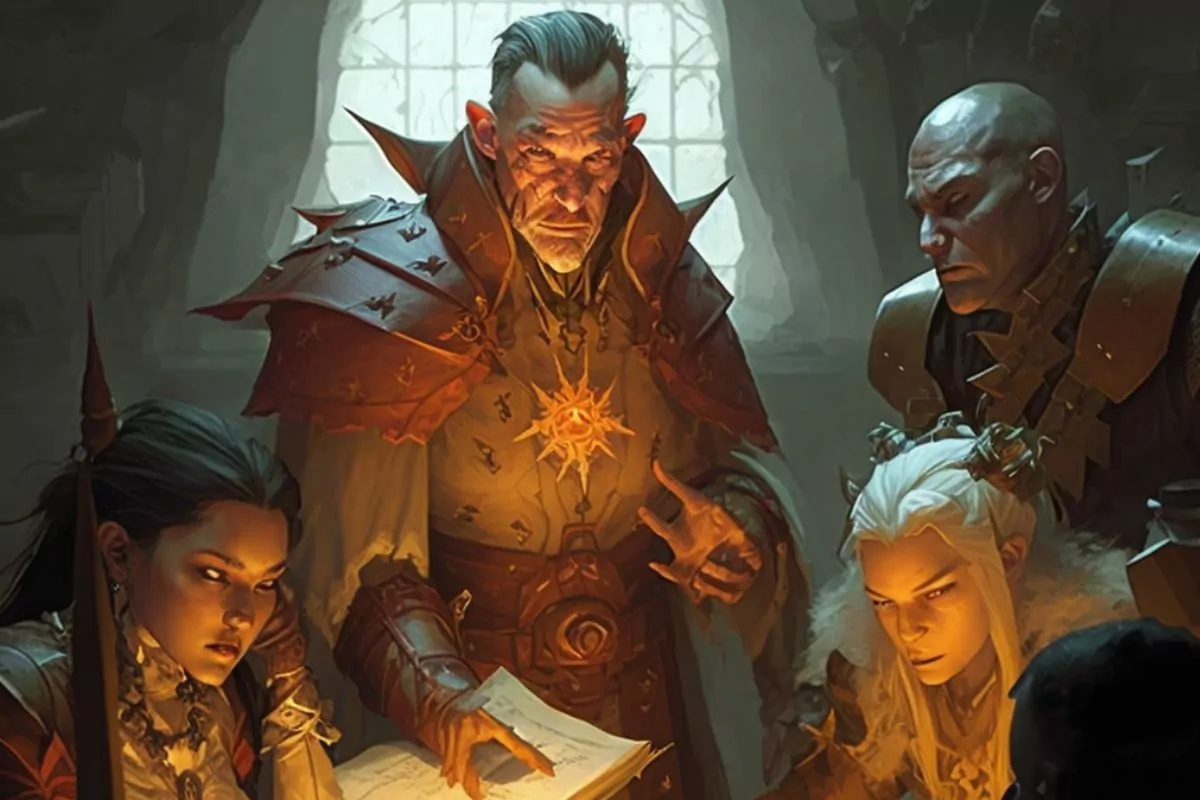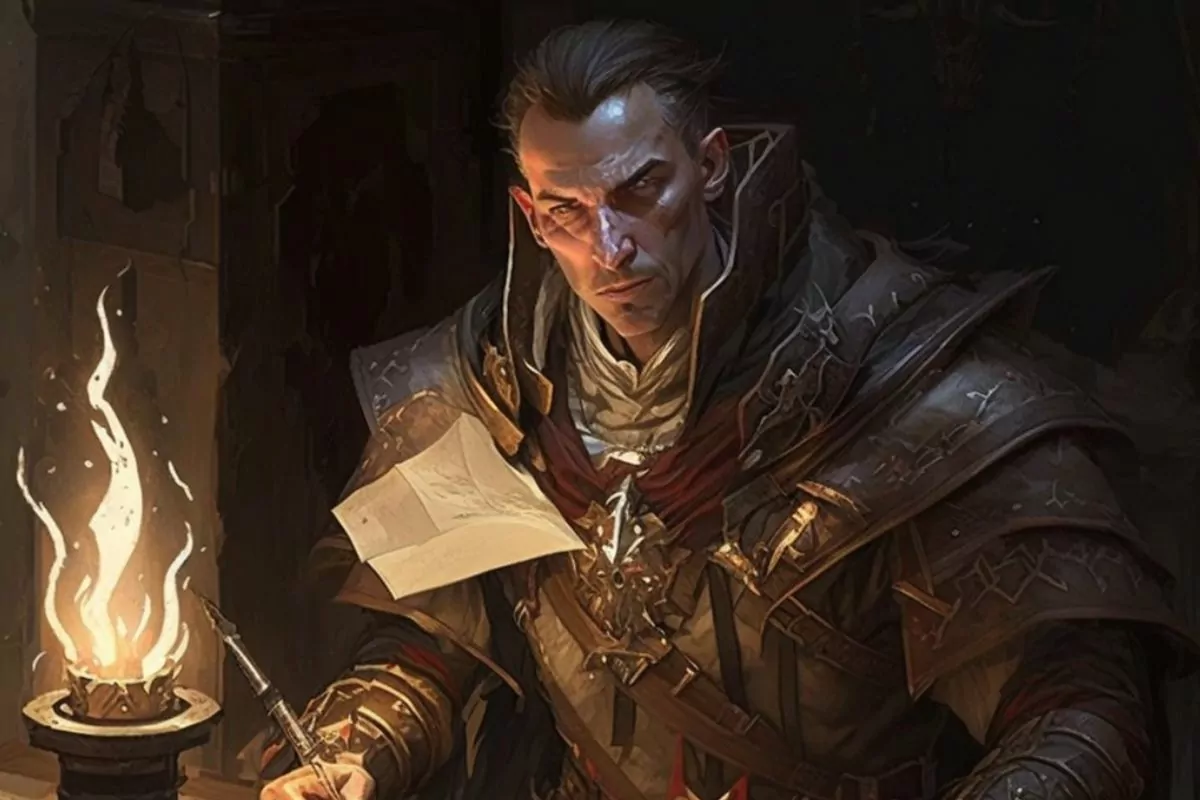Picture this: You’re playing a game of DnD, and your characters are out on the road or in the wilderness camping. You’ve got a fire going, and you’re about to get ready for a long rest.

And, out of the darkness, a pack or band of goblins run into the campfire light and start wailing on your team.
You draw your longbow, and fire an arrow into one of them, hoping that just one attack will be enough to stop them before they manage to sneak in another round of attacks and kill a character.
The arrow hits true, does 12 points of piercing damage… and the goblins don’t go down? And they’ve all got this? Are these zombie goblins? What is happening!? Or maybe your team is fighting the big bad of the campaign.
Their last layer action really did a number on your team, and the Cleric might be a little too late in the turn order to stop one of the parties from going down. It’s tense, it’s nerve-wracking, and another death could spell the end for your team.
Then, as the fighter of the party takes their actions, you find that you and your compatriots have got just that little bit more health in the tank, keeping the party up enough just enough for the Cleric to get in that Mass Cure Wounds that you all desperately needed.
The tide is turning, and victory is within your grasp. What you just saw are two examples of a little-known feat that often goes underutilized in Dungeons and Dragons (see also: A Complete Guide To Giant Apes In Dungeons & Dragons 5e)fifth editions, but can have massive potential when used in the right hands: the Inspiring Leader feat.
If you want to learn exactly what happened in these examples, and what this ability does for you and your party (and your GM for that matter), then make sure to read on!
What Is ‘Inspiring Leader’ In DND 5e?
So, before we get into the thick of this feat, and what makes it so great, we should probably at least describe the feat itself! This is a description of the feat as it is described:
‘You can spend 10 minutes inspiring your companions, shoring up their resolve to fight. When you do so, choose up to six friendly creatures (which can include yourself) within 30 feet of you who can see or hear you and who can understand you.
Each creature can gain temporary hit points equal to your level + your Charisma modifier. A creature can’t gain temporary hit points from this feat again until it has finished a short or long rest.’
How To Get It?
So, how exactly does a player get a hold of this feat for themselves? What class do they need to take to use this particular ability? Well, that’s the neat thing about feats. You don’t need to pick a class! Anyone can learn to use it!
How Feats Work?
Inspiring Leader, and all other feats as well, can be obtained whenever a player hits an ability score increase when leveling up their class.
They can either choose to increase one of their base ability scores by 2 points or they can select a feat from the list of available options, with Inspiring Leader being one of them.
Who Can Use It/Prerequisites?
So, Inspiring Leader is a feature that, in principle at least, can be picked up and used by anyone, right? Well, that’s the trick with this feat. Not just anyone can use this ability, as they need to be able to meet a prerequisite first. Inspiring leaders have to be well, inspiring!
They have to have the ability to hold the attention of a crowd or their fellow heroes, to be able to rally their spirits when hope seems lost through sheer charisma alone. Hmm. I wonder what ability would be good for this?
If our leading questions and statements weren’t making it clear enough, you’re going to need a pretty high Charisma stat to be able to use this ability in the first place. It will need to be at least 13 or higher, the same as if you were going to multiclass your character.
This means that this is an ability that is going to be easiest to use for many Charisma-based spellcasters like Bards, Paladin, Warlocks, and Sorcerers. Still, don’t let that put you off giving this ability to your Fighter character with 14 Charisma!
How Temporary Hit Points Work In 5e?
A few keen-eyed readers have probably noticed that the description for this feat states that it gives you temporary hit points, rather than simply restoring your standard hit points. So, what exactly is the difference between the two? Is one better than the other, maybe?
Well, temporary hit points in DND 5e do not fill up your standard health, but instead are added on top of your current health pool, kind of as a secondary bar of health.
If you are attacked, your temporary hit points will be used up first, before the damage then starts to affect your normal hit points when your temporary HP hits zero.
We should also note that temporary hit points (also known as temp. HP) cannot be healed if you have lost them from an attack.
A Cure Wounds or healing effect will only affect your normal HP, and not transfer over to those extra hit points that abilities like Inspiring Leader can grant.
As to whether or not one is better is kind of a misleading question. temporary hit points are, by their nature, designed to act as an extra buffer for your normal hit points. They complement one another, rather than one being better.
Why We Love Inspiring Leader In 5e?

Now, while this isn’t exactly a feat that has been forgotten about in 5e, it seems to have fallen a little by the wayside. Especially when compared to some of the more obviously useful feats, such as Tough or Sentinel.
However, this feat still has plenty of versatility when used in the right hands, and can offer some great bonuses to said players. These are just some of the things that always leave us tempted to add this to a character build when we reach level 4!
Great Utility For Many Builds/Classes
So, as we already mentioned before, this feat is an ability that can be picked up by any type of class, provided that they have at least 13 in Charisma.
This charisma-based feat makes it an ability that is primed to be picked up by Charisma-based spellcasters like Bards and Paladins.
These classes may already have some ways to heal or buff players, but the inspiring Leader allows these classes to do so before a big fight, without needing to spend precious spell slots to do so (which is especially great for the paladin, which gets fewer spell slots anyway as a half-caster).
This also gives casters that don’t have healing spells and features as standard to also have some extra utility. Warlocks and Sorcerers do not get healing abilities as standard parts of their classes, without choosing the Celestial patron or Divine Soul subclasses options, respectively.
If you’re not looking to go with either of these classes, this is an excellent utility feature to have handy for your fellow players and yourself.
And, again, even if you did pick one of these options, anyone who has played Warlocks knows how important their spell slots are. Why spend that precious one of a few spell slots to heal, when you have a feature that can also help buff your team?
Interestingly enough, and by the same token, this also allows martial classes that have selected Charisma as their secondary stat to also have some healing/buffing potential within a party. Monks, Fighters, Rogues.
Heck, even barbarians can have a little extra utility in the preparation for a big fight that is about to come up! (For our money, if you’re looking to double the effectiveness of a good temp. HP ability, this feat goes well with the Bannaret Fighter subclass, for extra rallying ability!)
There’s a common DND stereotype that it’s up to the Cleric to be the healer of a given party. But not only is it not just simply not true (looking at your Paladins, Druids, Bards, and Rangers), but it’s also a lot of responsibility to foist on a single player.
(It’s also arguably a bad strategy decision on your party’s part if your only healer goes down, and no one else is there to either pick up the slack or get the healer up.)
Spreading that responsibility of healing, buffing, and generally supporting other players around gives pretty much every player some way that they can help the party, and doesn’t restrict the one healer in the group to be just that. They can do other things too, which helps everyone enjoy the game a little more.
A Great Top-Up For Your Health
As we’ve already explained a little earlier in this guide, temporary hit points are not simply healing abilities for your normal health, but instead are added on top of your current health, whether you are at full health, or just at one hit point left.
While this may leave a few players frustrated that they can’t either heal up a downed player or heal any lost temp. HP, this does give a healthy boost to your health before a fight starts.
Let’s say that you’ve just reached level 4, and you have a character with a 14 (+2 modifier), and you’ve taken this feat. With the temp. HP for every level, plus your +2 modifiers, gives a player an extra +6 hit points before a fight starts.
That can be the difference between going down from an attack or staying up for your turn in a round of combat.
Add to that the fact that you can do this to up to 6 players, and that’s +36 HP that you can give your party in total with this ability, helping everyone stay in the game just that much longer. And that’s just with a +2 modifier at level 4! A +5 at the same level gives players +9 HP.
If you get to the highest level possible (level 20), you can give your allies up to +25 extra HP with this ability. Times that by 6, and that’s a cool 125 bonus hit points for your players to get hit around with!
Great Boost For Early-Level HP

Following on from our last point, not only is Inspiring Leader a great way to give everyone in your party, but it’s also a great feat to have for a lower-level player to have handy. It’s no secret that the first 5 to 7 levels of a DND character’s life are the squishiest and toughest.
Yes, you may be gaining crazy new abilities every level, but it might take 2 or 3 levels before you even manage to hit the double digits of normal HP, depending on what your class’s hit dice are, and whether or not you’re rolling for your health dice with each level-up.
So, any buff that you can get for those big fights is going to help you survive just that little better. At level 4, that extra 6 or 7 temps. HP is going to be felt in a game where 5s and 6s on damage rolls are going to be hitting your character regularly.
Readily Usable Feature
As any DND party will know, rest is crucial for keeping up your strength. Not only do you get your hit points back, but you’ll also be able to recharge some of the features you have that rely on rests to work.
Long rests take 8 hours in DND 5e and usually restore every feature that your class might have, as well as one hit point of exhaustion too. These can take a long time, however, and there’s no guarantee that your GM isn’t going to hit you with some kind of combat encounter while you are resting.
Short rests, meanwhile, only take an hour and allow you to heal a total equal to how many hit dice your character has. This option allows for some quick health healing, but also only allows for abilities that recharge on a short rest to be restored.
Fortunately, Inspiring Leader is just such an ability, able to be reused once a short or long rest has happened, allowing you to keep your party with temp. HP to spare in those long dungeon crawls where long rests are a death wish.
This will depend on the type of GM that is running your game. A Game’s Master who prefers long unbroken stretches of gameplay, punctuated by a few long rests, may not have much of a place for someone who has short rest features that their player.
Still, a good GM will take this into account, letting you get the most out of this ability, and being that much more effective
No Limit (In Theory)
Going back to the fine print of this feat, you notice that there is no stated time limit on these hit points. When discussing how long temp. HP lasts on a player that has them, the Player Handbook (PHB) has this to say:
‘Unless a feature that grants you temporary hit points has a duration, they last until they’re depleted, or you finish a long rest.’
This means that, if your GM is following the rules as they are written here, the hit points you gain do not have a time limit on them. They’ll stay until they are used up in a fight, or until your next long rest. At which point, you’re free to use Inspiring Leader again, getting those temp. HP back!
Things To Consider When Using Inspiring Leader In 5e
So, at this point, it’s starting to sound like Inspiring Leader is one of the best feats a player can take in DND 5e. And when used correctly and in the right hands, it certainly can be.
However, if you’re not planning around how to use this ability, you’ll quickly find that those great bonuses it gives players are either difficult to use effectively, or just a chore.
Long Preparation Time
It’s a fact that is sometimes forgotten by players until they need it. But Inspiring Leader is not like spells that can be cast in a single action or bonus action but are a 10-minute effect that will only work if the full time has been used.
This means that you’ll be unable to use this particular effect in the middle of a battle, and has to be used in a non-combat setting first. This isn’t a deal breaker, of course.
It just means that you’re going to need to plan when you’re going to use this better, such as immediately after a long rest, or the immediate prelude to a big fight.
Drop Off In Health
Don’t get us wrong, It’s not like this ability doesn’t have the potential to be incredibly effective, especially with a high Charisma stat. And no one is exactly going to say no to free temp HP before a big battle is coming.
Still, you may find that as you get higher in your character levels, the overall effectiveness of this ability starts to decrease, especially as your opponents start being able to do proportionally much more damage each turn.
No Stacking Ability
One of the main stipulations that temporary HP has on it is that it is not possible to stack it with other temp. HP affects normally, unless the ability says otherwise. This means that if you have any temp.
Leftover from a previous effect, maybe even the last time you used Inspiring Leader, you’ll lose any temp. HP that you had left over. So, unfortunately, you can stack up your Inspiring Leader HP to help counteract the relative lack of health at later levels.
More Difficult Encounters
This isn’t a negative for the Inspiring Leader feat per se, but it is a factor that you’re probably going to have to account for after a few sessions of having and using this feat. As we’ve already stated in this guide, there is no time limit to how long the temp.
HP lasts, meaning that you’re probably going to be using this ability often when you first get it, making surviving encounters a breeze. The GM is undoubtedly going to notice this.
And, to keep the tension up, will likely start adding even tougher monsters and opponents to your encounters to account for that.
Have you noticed how the first few fights where you have this ability were easier, only for the encounters to suddenly jump in difficulty after the 5th or 6th battle? Yeah, this is why!
This might turn having this ability active from a nice luxury into a necessity to survive even smaller fights. Again, this isn’t a dealbreaker for this ability, but it’s more likely than not to happen in your game.
Final Thoughts – Is Inspiring Leader A Good Feat?
So, overall, what is our verdict on this feat option for a player to take? Well, it certainly has some shortcomings, especially for players that like to play at the seat of their pants. Then again, are those players the ones that are thinking about party support?
Or are they wondering just how many dice they can roll for damage in a single turn? But if you’re prepared to plan a little with your abilities, any team will find this feat an incredibly helpful buff in battle!
- Thorn Whip 5e: Everything That You Need To Know - March 23, 2023
- The Complete Guide To Ice Knife In 5e - March 23, 2023
- The Complete Guide To Inspiring Leader In DND 5e - March 23, 2023
